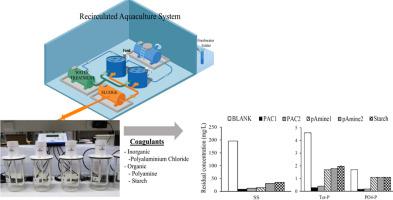Science of the Total Environment ( IF 8.2 ) Pub Date : 2020-06-20 , DOI: 10.1016/j.scitotenv.2020.140398 Elisangela Heiderscheidt 1 , Axumawit Tesfamariam 1 , Jani Pulkkinen 2 , Jouni Vielma 2 , Anna-Kaisa Ronkanen 1

|
Coagulants are widely used for solids (uneaten food, faeces, etc.) management in recirculating aquaculture systems (RAS), but no recent research has been performed on the effectiveness of different coagulants in treatment of aquaculture sludge. This study examined the effectivity of selected inorganic (polyaluminium chloride, PAC) and organic products (polyamine- and starch-based) as coagulant agents for solids management in RAS. Reductions in residual concentrations of total phosphorus (tot-P), phosphate‑phosphorus (PO4-P), suspended solids (SS) total nitrogen (tot-N), nitrate‑nitrogen (NO3-N), ammonium‑nitrogen (NH4-N), aluminium (Al) and chemical oxygen demand (COD) in reject water were determined. The effect of process parameters (coagulant type, dose, mixing and sedimentation time) on sludge treatment was also evaluated. The PAC products tested were most effective at concentrating pollutants (Tot-P, PO4-P, SS, COD) in RAS sludge into the solid phase. The organic products tested, especially a high-molecular-weight polyamine product (pAmine1), achieved good performance and can be considered a valid alternative to inorganic salts. At optimum dose, PAC (dose 32 mg/L) and pAmine1 (dose 15 mg/L) removed, respectively, 99.4% and 82.8% of turbidity, 98.2% and 65.4% of PO4-P and 97.7% and 73.6% of SS. The mixing time applied in flocculation and the time allowed for sedimentation had significant effects on coagulant performance, with the organic coagulants being most affected. Flocculation times of 5–15 min and sedimentation times of 15–60 min showed good results and can be used as a starting point in process optimisation with both inorganic and organic coagulants. The use of coagulants for treatment of RAS sludge enhances flock formation and improves particle settling characteristics, substantially decreasing nutrient, organics and solids concentration in reject water.
中文翻译:

淡水循环水产养殖系统中的固体管理:无机和有机混凝剂的有效性以及操作参数的影响。
凝结剂被广泛用于循环水产养殖系统(RAS)中的固体(阿联酋食品,粪便等)管理,但是最近尚未进行有关不同凝结剂在水产养殖污泥处理中的有效性的研究。这项研究检查了选择的无机(聚氯化铝,PAC)和有机产品(基于聚胺和淀粉)作为凝结剂在RAS中的有效性。减少总磷(tot-P),磷酸盐-磷(PO 4 -P),悬浮固体(SS)总氮(tot-N),硝酸盐-氮(NO 3 -N),铵态氮( NH 4-N),废水中的铝(Al)和化学需氧量(COD)进行了测定。还评估了工艺参数(凝结剂类型,剂量,混合和沉淀时间)对污泥处理的影响。测试的PAC产品最有效地将RAS污泥中的污染物(Tot-P,PO 4 -P,SS,COD)浓缩至固相。测试的有机产品,特别是高分子量的多胺产品(pAmine1),表现良好,可以被视为无机盐的有效替代品。在最佳剂量下,分别去除了PAC(剂量32 mg / L)和pAmine1(剂量15 mg / L),浊度的99.4%和82.8%,PO 4的98.2%和65.4%-P和SS的97.7%和73.6%。絮凝中的混合时间和沉淀时间对混凝剂的性能有重大影响,其中有机混凝剂受到的影响最大。絮凝时间为5–15分钟,沉降时间为15–60分钟,显示出良好的结果,可作为无机和有机混凝剂工艺优化的起点。使用凝结剂处理RAS污泥可增强鸡群的形成并改善颗粒沉降特性,从而显着降低废水中的养分,有机物和固体浓度。











































 京公网安备 11010802027423号
京公网安备 11010802027423号